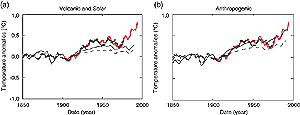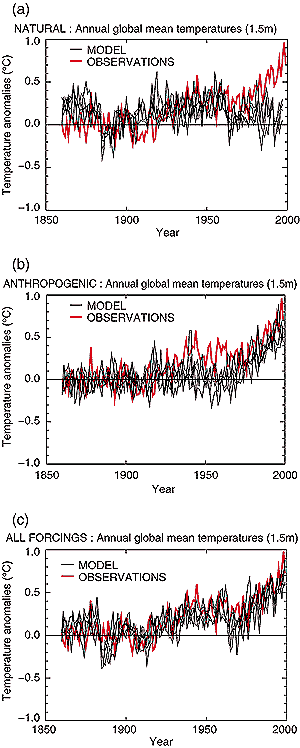Continued from previous page

Figure 12.6: (a) Five-year running mean Northern Hemisphere temperature
anomalies since 1850 (relative to the 1880 to 1920 mean) from an energy-balance
model forced by Dust Veil volcanic index and Lean et al. (1995) solar index
(see Free and Robock, 1999). Two values of climate sensitivity to doubling
CO2 were used; 3.0°C (thin solid line), and 1.5°C (dashed line).
Also shown are the instrumental record (thick red line) and a reconstruction
of temperatures from proxy records (crosses, from Mann et al., 1998). The
size of both the forcings and the proxy temperature variations are subject
to large uncertainties. Note that the Mann temperatures do not include data
after 1980 and do not show the large observed warming then. (b) As for (a)
but for simulations with volcanic, solar and anthropogenic forcing (greenhouse
gases and direct and indirect effects of tropospheric aerosols). The net
anthropogenic forcing at 1990 relative to 1760 was 1.3 Wm-2 , including
a net cooling of 1.3 Wm-2 due to aerosol effects. |
Studies linking forcing and response through correlation
techniques
A number of authors have correlated solar forcing and volcanic forcing with
hemispheric and global mean temperature time-series from instrumental and palaeo-data
(Lean et al., 1995; Briffa et al., 1998; Lean and Rind, 1998; Mann et al., 1998)
and found statistically significant correlations. Others have compared the simulated
response, rather than the forcing, with observations and found qualitative evidence
for the influence of natural forcing on climate (e.g., Crowley and Kim, 1996;
Overpeck et al., 1997; Wigley et al., 1997; Bertrand et al., 1999) or significant
correlations (e.g., Schönwiese et al., 1997; Free and Robock, 1999; Grieser
and Schönwiese, 2001). Such a comparison is preferable as the climate response
may differ substantially from the forcing. The results suggest that global scale
low-frequency temperature variations are influenced by variations in known natural
forcings. However, these results show that the late 20th century surface warming
cannot be well represented by natural forcing (solar and volcanic individually
or in combination) alone (for example Figures 12.6, 12.7;
Lean and Rind, 1998; Free and Robock, 1999; Crowley, 2000; Tett et al., 2000;
Thejll and Lassen, 2000).
Mann et al. (1998, 2000) used a multi-correlation technique and found significant
correlations with solar and, less so, with the volcanic forcing over parts of
the palaeo-record. The authors concluded that natural forcings have been important
on decadal-to-century time-scales, but that the dramatic warming of the 20th
century correlates best and very significantly with greenhouse gas forcing.
The use of multiple correlations avoids the possibility of spuriously high correlations
due to the common trend in the solar and temperature time-series (Laut and Gunderman,
1998). Attempts to estimate the contributions of natural and anthropogenic forcing
to 20th century temperature evolution simultaneously are discussed in Section
12.4.
Summary
We conclude that climate forcing by changes in solar irradiance and volcanism
have likely caused fluctuations in global and hemispheric mean temperatures.
Qualitative comparisons suggest that natural forcings produce too little warming
to fully explain the 20th century warming (see Figure 12.7).
The indication that the trend in net solar plus volcanic forcing has been negative
in recent decades (see Chapter 6) makes it unlikely that
natural forcing can explain the increased rate of global warming since the middle
of the 20th century. This question will be revisited in a more quantitative
manner in Section 12.4.
|

Figure 12.7: Global mean surface temperature anomalies relative
to the 1880 to 1920 mean from the instrumental record compared with ensembles
of four simulations with a coupled ocean-atmosphere climate model (from
Stott et al., 2000b; Tett et al., 2000) forced (a) with solar and volcanic
forcing only, (b) with anthropogenic forcing including well mixed greenhouse
gases, changes in stratospheric and tropospheric ozone and the direct
and indirect effects of sulphate aerosols, and (c) with all forcings,
both natural and anthropogenic. The thick line shows the instrumental
data while the thin lines show the individual model simulations in the
ensemble of four members. Note that the data are annual mean values. The
model data are only sampled at the locations where there are observations.
The changes in sulphate aerosol are calculated interactively, and changes
in tropospheric ozone were calculated offline using a chemical transport
model. Changes in cloud brightness (the first indirect effect of sulphate
aerosols) were calculated by an offline simulation (Jones et al., 1999)
and included in the model. The changes in stratospheric ozone were based
on observations. The volcanic forcing was based on the data of Sato et
al. (1993) and the solar forcing on Lean et al. (1995), updated to 1997.
The net anthropogenic forcing at 1990 was 1.0 Wm-2 including a net cooling
of 1.0 Wm-2 due to sulphate aerosols. The net natural forcing for 1990
relative to 1860 was 0.5 Wm-2 , and for 1992 was a net cooling of 2.0
Wm-2 due to Mt. Pinatubo. Other models forced with anthropogenic forcing
give similar results to those shown in b (see Chapter
8, Section 8.6.1, Figure
8.15; Hasselmann et al., 1995; Mitchell et al., 1995b; Haywood et
al., 1997; Boer et al., 2000a; Knutson et al., 2000).
|

